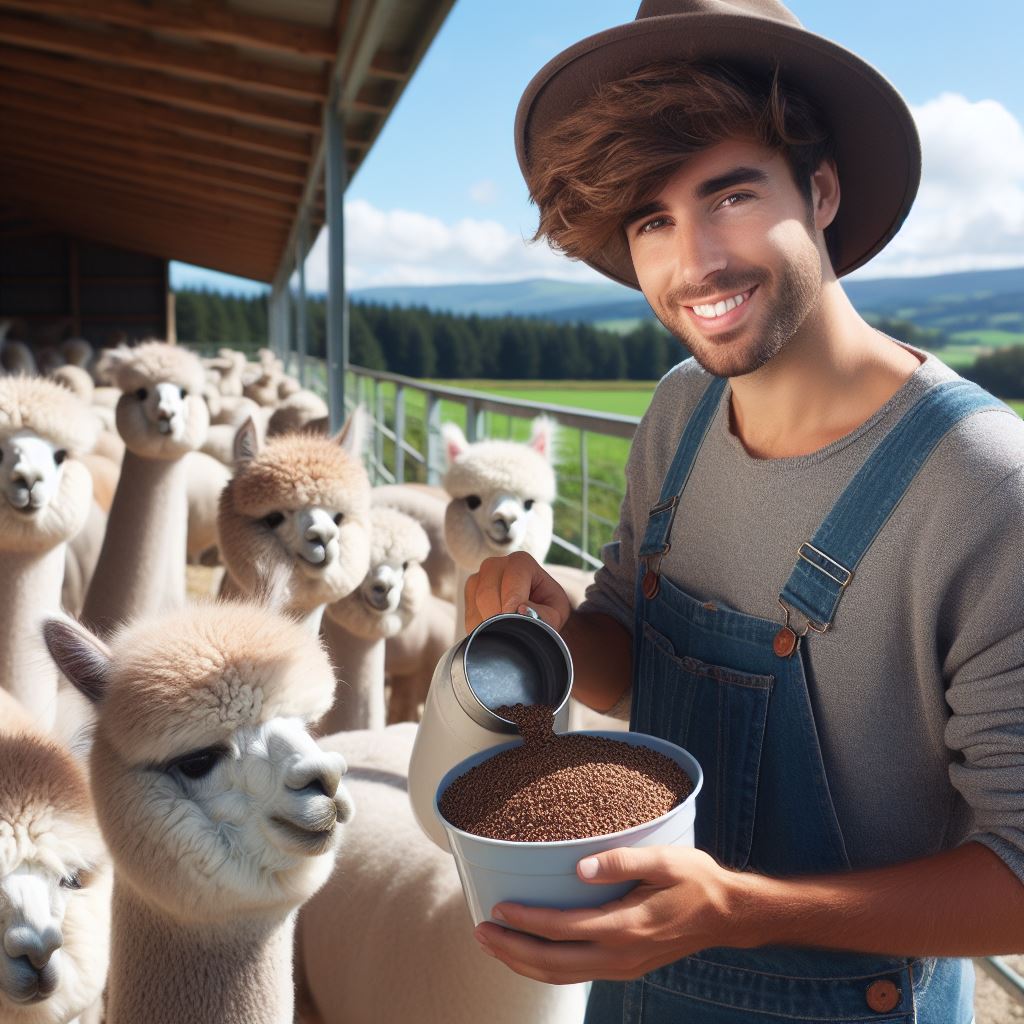Introduction
Importance of nutrition for alpaca fleece quality
Let’s Explore Alpaca Feed Tips: Nutrition for Fleece Quality
Nutrition plays a vital role in the production of high-quality fleece in alpacas.
Alpacas are prized for their fine and luxurious fiber, and by providing them with the right nutrients, you can optimize the quality of their fleece.
The blog post aims to guide alpaca owners on the importance of nutrition and provide valuable tips on how to enhance their alpacas’ fleece quality through proper feeding practices.
Purpose of the blog post
Alpaca fleece is highly sought after in the textile industry due to its softness, warmth, and hypoallergenic properties.
To achieve these desirable characteristics, alpacas need to consume a balanced diet that ensures their fiber growth and overall health.
By focusing on nutrition, you can improve the fineness, density, and crimp of the alpaca fleece, making it more valuable and in-demand.
It’s essential to understand the specific nutritional requirements of alpacas to tailor their diet accordingly.
Feeding alpacas a diet rich in protein, vitamins, and minerals, such as quality hay, fresh grass, and specially formulated alpaca pellets, can promote healthy fiber growth and maintain optimal body condition.
In addition to the primary feed, supplementing their diet with essential nutrients like Omega-3 fatty acids can also enhance the quality of the fleece.
These nutrients help improve the softness, luster, and strength of the fiber.
It is crucial to monitor alpacas’ body condition to ensure they are receiving adequate nutrition without becoming overweight, as excessive fat deposits can negatively affect fleece quality.
Basically, providing proper nutrition is key to enhancing alpaca fleece quality.
By following the tips shared in this blog post, you can optimize your alpacas’ health and overall fiber value, making it a win-win situation for both alpacas and their owners.
Understanding Alpaca Nutrition
Overview of alpaca digestive system
Alpacas have a unique three-chambered stomach, similar to that of a camel.
Transform Your Agribusiness
Unlock your farm's potential with expert advice tailored to your needs. Get actionable steps that drive real results.
Get StartedThis specialized digestive system allows them to efficiently extract nutrients from their food.
- The first chamber, the rumen, is where fermentation occurs. It contains beneficial bacteria and microorganisms that break down cellulose.
- The second chamber, the reticulum, acts as a filter and helps with the regurgitation of food for further chewing.
- The third chamber, the omasum, absorbs water from the partially digested food.
Essential nutrients for optimal fleece quality
To maintain and improve the quality of alpaca fleece, it is crucial to provide them with a well-balanced diet rich in essential nutrients.
- Protein: Alpacas require a diet high in protein for optimal fleece growth and quality. This can be achieved through the consumption of legumes and high-quality grasses.
- Vitamins and minerals: Alpacas need a wide range of vitamins and minerals to support healthy fleece development. This includes vitamin D, vitamin E, copper, zinc, and selenium.
- Omega-3 fatty acids: These are essential for maintaining a soft and lustrous coat. Adding flaxseed or fish oil to their diet can help increase omega-3 intake.
Typical diet of alpacas
Alpacas are herbivores and primarily graze on grass and other vegetation.
However, their nutritional needs can vary based on factors such as age, sex, and the overall health of the animal.
- Pasture and forage: Fresh, high-quality pasture is the foundation of an alpaca’s diet. Good pasture provides a variety of grasses and legumes that are rich in essential nutrients.
- Hay: During the winter months or when pasture availability is limited, alpacas rely on hay as their main source of forage. It is important to offer them clean, nutrient-rich hay.
- Supplements: In some cases, alpacas may require additional supplementation to ensure they meet their nutritional requirements. This can include mineral blocks and specialized alpaca feed mixes.
- Water: Adequate water intake is crucial for alpaca health and fleece quality. Alpacas should have access to clean, fresh water at all times.
In essence, understanding alpaca nutrition is essential for maintaining optimal fleece quality.
By providing a well-balanced diet rich in essential nutrients, alpacas can thrive and produce high-quality fleece.
It is important to consider their unique digestive system and provide them with the appropriate diet to support their overall health and well-being.
Read: Nutritional Needs of Turkeys: A Complete Guide
Tips for Alpaca Feeding
Alpacas are beautiful and unique animals known for their incredibly soft and luxurious fleece.
If you’re a proud alpaca owner or considering getting into the business, it’s important to understand the crucial role nutrition plays in maintaining top-quality fleece.
In this section, we will explore some key tips for alpaca feeding to ensure optimal fleece quality.
Providing high-quality forage
Poor nutrition can result in weak and brittle fibers, negatively affecting the quality of alpaca fleece.
It is essential to provide fresh and nutrient-rich forage to support their overall health and fleece development.
Alpacas should have access to pasture or hay that is free from mold, weeds, or other contaminants.
Different types of forage are suitable for alpacas, including grasses like timothy, Bermuda, and orchard grass, as well as legumes such as clover and alfalfa.
The right balance of these forages can contribute to improved fleece quality.
Ensuring proper mineral supplementation
Minerals are vital for the health of alpaca fleece.
Copper, zinc, selenium, and iron, for example, play key roles in fleece growth and strength.
Alpacas may not receive adequate minerals from forage alone, so it’s crucial to provide proper mineral supplementation.
There are different methods of mineral supplementation for alpacas, including free-choice mineral mixes, mineral blocks, or mineral pellet supplements.
Consulting with a veterinarian or nutritionist can help determine the appropriate type and quantity of minerals for your alpacas.
Understanding the role of protein in fleece quality
Protein is an essential component of alpaca feed that directly affects fleece quality.
It provides the necessary building blocks for fiber growth and strength.
Understanding the optimum protein requirements for alpacas is key to maintaining top-quality fleece.
Showcase Your Farming Business
Publish your professional farming services profile on our blog for a one-time fee of $200 and reach a dedicated audience of farmers and agribusiness owners.
Publish Your ProfileIn general, alpacas require a diet containing around 16-18% protein.
Good sources of protein in alpaca feed include legumes, such as alfalfa and clover, as well as certain grains like soybean meal.
Avoiding common feeding mistakes
To ensure the best fleece quality, it’s important to avoid common feeding mistakes that can negatively impact alpacas’ health and fleece.
Overfeeding or underfeeding alpacas can lead to poor fleece growth or excessive weight gain, respectively.
Moreover, providing unsafe or low-quality feed can have detrimental effects on alpacas’ overall well-being and fleece quality.
Always choose feed from reputable sources and monitor your alpacas’ intake to prevent any feeding-related issues.
In fact, proper nutrition is essential for achieving and maintaining optimal fleece quality in alpacas.
Providing high-quality forage, ensuring proper mineral supplementation, understanding protein requirements, and avoiding common feeding mistakes are key factors in promoting healthy and luxurious alpaca fleece.
By following these tips, you can keep your alpacas happy, healthy, and their fleece at its finest.
Read: Llama Feeding Basics: Health & Nutrition Tips

Feeding Considerations for Different Life Stages
Feeding crias (baby alpacas)
Alpacas, or crias, requires special attention to their unique nutritional needs.
Their delicate digestive systems can be easily upset, so it is important to provide them with a diet that supports their growth and development.
Unique nutritional requirements for crias
Crias require a diet rich in vitamins, minerals, and protein to support their rapid growth.
They also need access to high-quality forage and clean water.
Additionally, it is essential to provide them with a balanced diet that meets their specific needs.
Milk replacers and weaning process
In some cases, crias may need to be bottle-fed with milk replacers if they are unable to nurse from their mothers.
It is important to gradually introduce solid foods to their diet during the weaning process.
This helps them transition from milk to a solid diet without digestive issues.
Feeding pregnant and nursing alpacas
Pregnant and nursing alpacas have higher nutritional needs compared to other stages in their lives.
Proper nutrition during these periods is crucial for their own health and that of their offspring.
Increased nutritional needs during pregnancy
During pregnancy, alpacas require a well-balanced diet that provides them with the necessary nutrients to support the development of their unborn cria.
This includes an increased intake of energy, protein, and essential vitamins and minerals.
Supporting lactation and milk production
After giving birth, alpacas need a diet that supports their lactation and milk production.
This involves providing them with adequate amounts of protein, calcium, and phosphorus.
Proper nutrition during this stage ensures that the crias receive the necessary nutrients for their growth and overall health.
Feeding older alpacas
As alpacas age, their nutritional needs change, and adjustments to their diet are necessary to maintain their health and well-being.
Adjusting feed for aging alpacas
Older alpacas may have difficulty properly digesting certain types of feed.
It is important to provide them with easily digestible forage and monitor their weight to ensure they are receiving enough nutrients without becoming overweight.
Addressing dental issues and potential nutrient deficiencies
As alpacas age, they may experience dental issues that affect their ability to chew and digest their food properly.
Regular dental check-ups and, if necessary, adjustments to their diet can help address these issues.
Additionally, older alpacas may be more prone to nutrient deficiencies, so it is important to monitor their diet to ensure they are receiving all the necessary nutrients.
By considering the specific nutritional needs of alpacas at different life stages, you can ensure their overall health, well-being, and fleece quality.
Read: Buffalo Feeding Guide for Better Meat Quality
Monitoring and Evaluating Fleece Quality
Importance of Regular Fleece Inspections
- Regular fleece inspections are crucial to ensure the quality of alpaca fleece.
- These inspections help identify any issues early on and prevent further damage to the fleece.
- Inspections allow breeders to track the progress and health of their alpacas’ fleece.
- Regular inspections enable breeders to take necessary actions to maintain and improve fleece quality.
- By inspecting the fleece, breeders can detect any signs of skin infections or parasites.
Evaluating Fleece Based on Various Factors
- Fleece should be evaluated based on its fineness, staple length, density, and uniformity.
- Fineness refers to the diameter of individual fibers and is an essential quality indicator.
- A long staple length indicates healthy and well-nourished alpacas.
- High fleece density is desired as it provides better insulation and protection for the alpacas.
- Uniformity ensures that the fleece is consistent in terms of quality and characteristics.
- Breeders can use micron testing to determine the fineness of the fleece accurately.
- The presence of guard hair or kemp fibers in the fleece is undesirable and affects its value.
Adjusting Feeding Regimen Based on Fleece Quality Changes
- Changes in fleece quality may indicate nutritional deficiencies or imbalances.
- If the fleece quality deteriorates, breeders should assess the alpacas’ diet and make necessary adjustments.
- Increasing the protein content in the feed can improve fleece growth and quality.
- Providing a well-balanced diet with sufficient vitamins and minerals promotes healthy fleece development.
- Breeders should consult with a nutritionist or veterinarian to develop an optimal feeding regimen.
- Regular monitoring of the alpacas’ weight and overall health is crucial when adjusting the feeding regimen.
- Adjustments should be made gradually to avoid digestive upsets and ensure the alpacas’ well-being.
Regular fleece inspections play a significant role in maintaining and improving the quality of alpaca fleece.
By evaluating the fleece based on factors such as fineness, staple length, density, and uniformity, breeders can track and enhance the quality of their alpacas’ fleece.
Adjusting the feeding regimen based on changes in fleece quality ensures that the alpacas receive the necessary nutrients for optimal fleece growth.
Monitoring and evaluating fleece quality are essential tasks that require attention and expertise to promote the overall well-being of alpacas and their valuable fleece.
Read: Deer Farming Feed Strategies for Growth & Health
Conclusion
The quality of an alpaca’s fleece can be significantly enhanced through proper nutrition and feeding.
By following a few key tips, alpaca owners can ensure that their animals receive a balanced and nutritious diet, leading to better fleece quality.
Showcase Your Farming Business
Publish your professional farming services profile on our blog for a one-time fee of $200 and reach a dedicated audience of farmers and agribusiness owners.
Publish Your ProfileTo recap, some important tips include providing high-quality hay, a mineral and vitamin supplement, and access to fresh and clean water.
Additionally, it is crucial to monitor weight and body condition to ensure the alpaca is maintaining a healthy weight.
The importance of a balanced and nutritious diet cannot be overstated.
A diet lacking in essential nutrients can result in poor fleece quality and overall health issues for the alpacas.
Therefore, it is crucial to prioritize their diet to maintain their well-being.
Lastly, seeking professional guidance and assistance from experienced vets is highly encouraged.
They can provide tailored advice and conduct regular check-ups to ensure the alpacas’ nutritional needs are met.
By implementing these tips and seeking professional assistance when needed, alpaca owners can take proactive steps to improve the fleece quality and overall health of their beloved animals.
With proper nutrition, alpacas can enjoy a long and healthy life, while also producing high-quality fleece.




